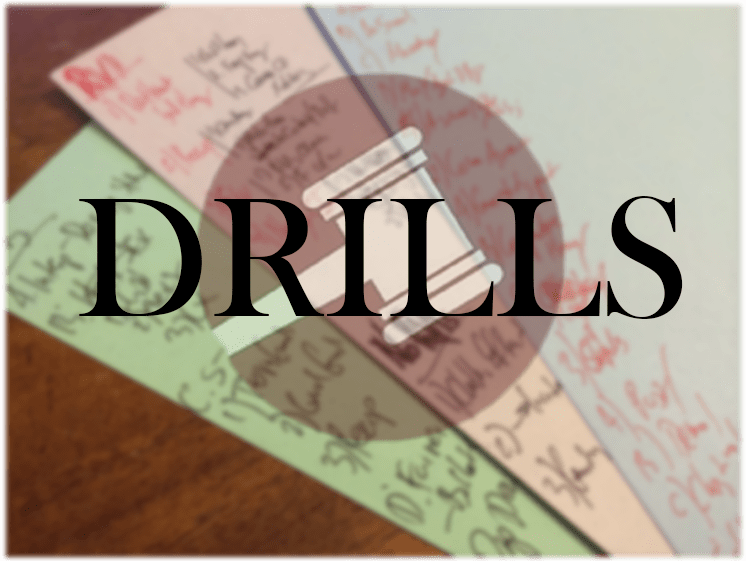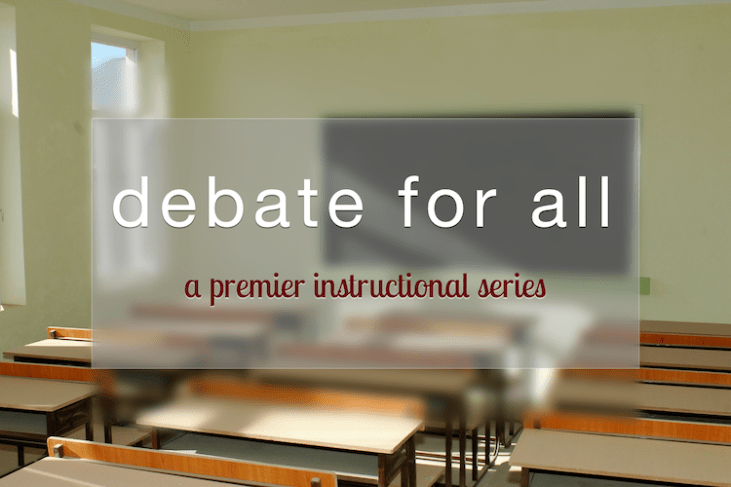Drill of the Week – Pre-Round Prep (TOC Edition)

We didn’t see a ton of plans on the 2018 January-February topic, but TOC is a time for innovation. We’ve now had two months since the last major invitational tournament, and many teams, especially top teams, should be thinking about how the rest of the pool has been prepping their disclosed affs during that time. Is that prep good enough to warrant throwing out the old affs, or merely revising them, writing better frontlines?
Some of the best teams will stick to their version of the Michelle Alexander ‘crash’ aff, hoping their chops on the stock solvency debate will outshine negs that have had months to prep, but others will break completely new aff strategies, especially in late prelims and early elims.
Given the paucity of legitimate solvency advocates on this topic and passive voice wording, the potential for new plans is quite high, despite the prevalence of T-abolish. If you’re going to TOC, you’ll need a generic strategy that can apply to new plans.
Instructions
Let’s assume you’re lucky enough to know the aff plan text. Perhaps your opponent disclosed it, or you heard it through the grapevine. The plan is “The United States federal government ought to abolish plea bargaining for domestic terrorism suspects in the criminal justice system.” You don’t know anything else about the aff, but this is your opponent’s wiki:
- (Aff): ‘Crash the Courts’ with Oppression/Structural Violence FW
- (Aff): Immigrants Plan with Util FW and high probability impacts first weighing
- (Neg): Mueller PIC, Mueller DA, Midterms DA, Court Packing DA, Terror DA, Organized Crime DA, Cartels DA, Court Clog DA
- (Neg): Afropessimism K, Cap K (stock version), Cap K (Baudrillard version)
- (Neg): T vs. Non-T affs, T-Abolish = All
You might know a debater who reads similar arguments and can imagine a particular opponent for the purpose of this drill, but it’s not necessary.
Step 1, Judges (3:00): At a tournament, you’ll always know the judge, but for the purpose of prep, you want to think about what types of judges you’ll get in what types of rounds (and what types of judges you want in these debates). Pull up the TOC judge entry list, and try to find five judges you’d likely have in a debate with this opponent. Have these judges in mind during the rest of the drill.
- Tip: If you’re a more consequentialist debater, you’re probably looking for mutual 1s; if you’re more kritik-y, mutual 2s; and more philosophy, mutual 3s.
Step 2, Envision the Aff (5:00): Based on your own files, the wiki, and internet searches, try to outline what you think the aff might look like. Is there really only one best version of this aff, or are there two or three options? Try to flesh out at least your best two hypotheses.
- Tip: Be creative. This debater has big stick util neg strategies, an oppression aff, and some kritiks. Are there possibilities for an aff with this plan text across different argument types?
- Tip: Think about what debaters are doing with plans on this topic. It’s possible this is a new plan, but the structure of the aff is similar to what we’ve seen earlier on the topic.
Step 3, Craft 1NCs (10:00): Put together a 1NC speech document for each of your best two hypotheses about what the aff could look like. Take ~5:00 for each.
- Tip: Think about what the ideal 2NR is against the type of aff you’ve envisioned. How can you set up the 1AR to under-allocate on your 2NR strategy? What other off cases should you include to force the 1AR to diversify?
- Tip: Time your off case positions in advance of a tournament. You don’t want to be worrying about what you can/can’t fit in the 1NC right before the start of the round, and you definitely don’t want your strategy to suffer because you anticipated having more or less time than you do.
Step 4, Fine-Tune the 1NCs (7:00): Given your decisions about what off cases to include and what case objections you might make in each 1NC, you’ll need to fine-tune them to apply to this particular aff. Write in these interactions so you have them ready to go and don’t need to spend prep and speech-time thinking about what you need to change.
- For topicality and theory, modify your ground/limits standards to be specific to this type of affirmative. E.g. if what’s bad is that the aff specifies an actor, you should list the possible actors to justify a predictability/limits argument and the types of ground excluded because of the aff’s actor choice. If what’s bad is that the aff abolishes a subset of plea bargains, you should list types of plea bargains available.
- For topicality specifically, always include a topical version of the aff to solve opponent ground/education-based offense.
- For disads, kritiks, and NCs, you should have specific link arguments based on the aff, not just plea bargain bans in general. You should weigh your impacts against aff offense that interacts or in expectation of what the 1AR offense against your position might be.
- For counterplans, you should say how it solves the aff advantages specifically.
- For case turns, weigh them against the aff advantages and apply them specifically to the context of the plan.
Step 5, Review & Assess: This is a pretty good simulation for what pre-round prep with a new plan at TOC will look like. How did you do? Review each step, and if you can, discuss with teammates or coaches. Did you accurately assess the judges you could have in a debate like this? Did you think creatively about the possible ways an aff with this plan text could be built? Did your 1NC include the best arguments you’ve prepped for each type of aff? Are there neg strategies you’d like to pursue, but need to do more research and writing to prepare for a debate like this?
- Tip: I suspect one of the harder parts of a drill like this is concretely envisioning an aff you’ve never seen before. If that hinders your ability to do the full drill, pick two of these as candidates for what this aff could look like (which do you think is most probable given your opponent’s wiki?):
- #1: Util framework, plan, solvency, racism/islamophobia advantage (domestic terrorists target particular groups and the aff deters, holds them accountable, and prevents repeat offenses), short topicality/kritik preempts in the underview.
- #2: If you’re more kritik-y, same substance as #1 but with an oppression framework and heavy kritik preempts. If you’re more framework-y, same substance as #1 but with an extra long util framework and no kritik preempts.
- #3: ROB/ROJ about imperialism and contention about how plea bargains used as intel-gathering measures fuel the war on terror / militarism / islamophobia. Offense seems to have a pre-fiat/performative element, and the aff includes kritik-type topicality preempts.
- #4: Util framework with a nuclear terrorism advantage (extinction), plea bargains lead to bad intel, and aggressive warfighting in the Middle East causes blowback from terrorist groups, extinction first weighing.
Points of Emphasis
- Flexibility. You don’t want to be locked into one option (say, topicality or plans bad) when you hit an aff like this, so make sure your strategy includes multiple real, credible options for the 2NR. If you don’t, then an aff that includes more kritik preempts, say, or more theory preempts might catch you off guard and hedge against the only argument you envisioned going for.
- Test your prep. If you lack generic options to deal with a brand new plan aff, then you won’t be ready for opponents who break new, and you’ll feel frenzied/pressured in pre-round prep. If your prep is solid, then you can use this time to assess strategy and do spot research for a counterplan or more specific links you might need.
- Improve your speed and research/writing capabilities. If formulating a 1NC strategy for a particular aff is taking too much time, you might need to change your file organization, use Verbatim more effectively, or spend less time on the finer points of your strategy and more time nailing down the general approach. Know which parts of your strategy need to be adapted/fine-tuned, so you can go there directly. Plan in advance what type of research you can do in a short amount of time (are you looking at their evidence? trying to find a counterplan or politics link? etc.), and how you’ll do it (what search engines / databases).
Extensions & Variations
- New plan. Have a teammate or coach come up with a new plan text with which you can do the same drill. Does the same general strategy apply? Now that you’ve done the drill once, can you save prep time in Step 3 and do a little research that might help with Step 4?
- Continue the round. Suppose you’re the aff. What’s the best 1AR to this 1NC? Does it involve initiating new theory or other off cases? Collapsing to one or two layers? Take 5:00 to formulate the best 1AR (and deliver it if you can). Then deliver the 2NR.
Want to learn more drills like this? Apply to attend Premier Debate Institute in Summer 2018! Learn more at premierdebate.com/camps.
We accept submissions for instructional drill posts. If you have a basic or advanced drill you’d like to be featured or you want to write/edit for Premier Debate, please contact us!



